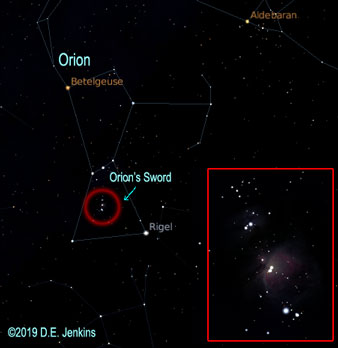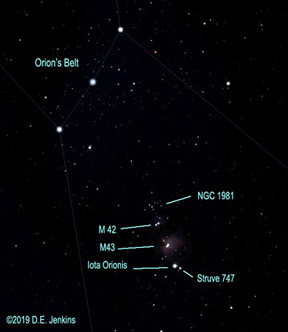
December 2019 - Vol. 23, No. 12
This Month's Night Sky - NOTE: The next paragraph describes the sky as it appears at 10 pm EST (11 pm EDT) near mid- month. The sky also looks this way at 11 pm EST (midnight EDT) during the beginning of the month and at 9 pm EST (10 pm EDT) by month's end.
Some believe the winter night sky is the most beautiful of the year! By mid-month, misty Pleiades, the famous open star cluster of the constellation Taurus, is visible due S. at 10 pm. Although part of the constellation Taurus, it lies above its "lazy V" asterism whose brightest star, orange-tinted Aldeberan, glows near the point of the lower branch of the "V". Above are the constellations Perseus, Cassiopeia (whose "W" shaped asterism is unmistakable) and Auriga. Lovely Orion, whose asterism reminds me of a slightly lopsided hour glass, moves upwards from the SE. Note its three "belt" stars located at the "pinch" of the hour glass. The hazy object below the middle belt star is M42, the Great Orion Nebula, a region of space where stars are being born. Orion is followed by the bright stars Procyon (Canis Minor) and Sirius (Canis Major). Along with the bright star Betelgeuse (Orion), these three stars form the famous "Winter Triangle". To the E shine the Gemini twins, Castor and Pollux. In the SW, the diamond-shaped Great Square of Pegasus stands on one corner while high in the N, Ursa Major's asterism, the Big Dipper, stands on its "bowl".
MERCURY in the morning sky will be more easily seen from the northern hemisphere. VENUS will rise higher in the evening sky for the northern hemisphere and will show off at magnitude -3.9. Keep watching our sister planet as she prepares to dazzle us in the northern sky next year. MARS emerges into the morning sky, still and distant but brightening to at 1.6 mag this month. JUPITER is very low in the evening sky this month, moving toward conjunction with the Sun on the 27th. SATURN in the evening sky is visible with difficulty in twilight. URANUS in Aries will set in the early morning hours. NEPTUNE sets around midnight.
Review how to determine Angular Measurement.
Calendar of Events
NOTE: For those observers not in the ET zone, convert the calendar times to your zone's time by subtracting one hour for CT, two for MT and three for PT. Don't forget to adjust for Daylight Savings Time when necessary by subtracting one hour from your planisphere's time. Dawn and dusk times must also be corrected. See your local newspaper, TV news, or cable TV's Weather Channel for sunrise and sunset times or check with the U.S. Naval observatory. Unfortunately some of these events may occur during daylight hours in your area.
| DATE | EVENT |
| 05 | Moon at apogee. |
| 08 | Uranus 5 deg N. of Moon. |
| 11 | Venus 1.8 deg S. of Saturn. |
| 13 | Moon 1.5 deg S. of M-35 star cluster. |
| 14 | Geminids meteor speak. This meteor shower is unusual in that it is associated with the 3200 Phaethonan asteroid that orbits the Sun every 1.4 years. Most showers are associated with periodic comets. The Although the Geminid shower may produce about 120 meteors per hour at its peak, this year a last quarter moon will rise near to the radiant hampering observing. |
| 15 | Moon 1.0 deg N. of M-44 (Beehive) star cluster. |
| 18 | Moon at perigee. |
| 19 | Mercury at descending node. |
| 20 | Venus at greatest heliocentric latitude S. |
| 22 | Solstice, winter begins in the northern hemisphere, while summer begins in the south. |
| 23 | Mars 4 deg. S. of Moon. Ursid meteor shower produces 10 meteors at its peak. |
| 26 | Annular solar eclipse visible from Asia, Indonesia, India, Saudi Arabia, eastern Africa, the Marianna Islands and Guam. The greatest eclipse occurs at 5:13 UT when 94.12 percent of the Sun's disk will be covered by the Moon and will occur on the island of Sumatra. NASA Eclipse website and Google map of the December 26, 2019 eclipse. Other sources are also available on the internet. |
| 27 |
Jupiter in conjunction with the Sun. Saturn 1.2 deg. N. of Moon. Pluto 0.5 deg N. of Moon, occultation from south S. America, Kerguelen Island, parts of Antarctica, and S. tip of Africa, S. Madagascar. (Need a large scope for this event!!) |
| 29 | Venus 1.0 deg. N. of Moon, occultation from Antarctica, and southern tip of S. America. |
| 30 | Mercury at aphelion. |
Lunar Almanac for December 2019
| Phases of the Moon | Phase and Date(s) | Best viewed before local midnight |
 |
New 26 |
Deep Space Objects |
 |
1st. Qtr 04 |
Planets & Moon |
 |
Full 11 |
Moon |
 |
Last Qtr 18 |
Deep Space & Planets |
Topic of the month: Orion, the Great Nebula, and the Sword
 The December sky brings us our old winter favorites, Orion, Gemini and Canis Major, virtually invisible all summer long. The constellation of Orion is thought to represent a great hunter, with his two hunting dogs (Canis Major and Canis Minor.) This constellation boasts of two first magnitude stars, the red giant Betelgeuse and the brilliant blue star Rigel. Three second magnitude stars form a line in the giant's center section: Alnitak, Alnilam, and Mintaka. These stars have been known as the Three Kings as well as the Three sisters. The "head" of this giant figure is poorly represented by three stars in a triangle shape. The brightest and best known of these is Lambda, a double star.
The December sky brings us our old winter favorites, Orion, Gemini and Canis Major, virtually invisible all summer long. The constellation of Orion is thought to represent a great hunter, with his two hunting dogs (Canis Major and Canis Minor.) This constellation boasts of two first magnitude stars, the red giant Betelgeuse and the brilliant blue star Rigel. Three second magnitude stars form a line in the giant's center section: Alnitak, Alnilam, and Mintaka. These stars have been known as the Three Kings as well as the Three sisters. The "head" of this giant figure is poorly represented by three stars in a triangle shape. The brightest and best known of these is Lambda, a double star.
Many observers tune into the Great Nebula in Orion, that is part of the sword this hero carries. The Orion Nebula is considered the most observed object in the sky. The great nebula is about 1,500 light-years away and it is one of the closest star-forming region to Earth. It is known best as M-42, recognized years ago by Charles Messier. At 4th magnitude, M42 can be seen with the naked eye.
In the center of the nebula is the star that has been designated as Theta Orionis. Theta ORI is actually a multiple star, consisting of four primary members that can be easily seen in binoculars especially if the component labeled B is at the brighter phase of it's period. It is also called the Trapezium because of the pattern formed by the 4 largest stars. In a small telescope on a clear night, a fifth component labeled E may also be visible. More difficult is the component F which is close to the brightest star of the group, the C component. Many stars in the Orion Nebula are variable because they are so young. The ultraviolet light streaming from these stars has cleared the dust surrounding them, enabling us to see them shining in their stellar nursery. The Nebula itself is part of the spiral arm of the Milky Way. What a challenge the nebular stars can be to a variable star observer!
Orion's Sword

Orion's sword is one of my favorites both in a telescope and in binoculars. Although the Great Orion Nebula (M42) is a wonderful sight in a good telescope, binoculars show many of the brighter sword objects in a single view. Both M-42 and M-43 are bright diffuse nebulae. They are hard to separate when viewed by binoculars. These are regions where stars are being formed. (At least they were being formed when the light entering your binoculars left the nebula some 1600 years ago!)I like to think of the Orion Nebula as a great bird where M-43 is the head and M-42 is the body of the bird with its wings outspread. NGC 1981 is an open cluster of about 10 stars embedded in a vast dust cloud. These stars are also embedded in a dusty nebula and astrophotos taken in this area reveal a rich, red and blue or violet haze surrounding the stars. Iota Orionis is the brightest star in this area of the field and Struve 747 a double star that can be "split" by tripod mounted 10x50's.
I'll end this year's last issue with a big HAPPY HOLIDAYS to all!
--See You Under the Stars!
Astra for Astra's Almanac
This installment of "What's Up?" is ©2019 by Dawn Jenkins for Astra's Stargate. View Ron Leeseburg's Farewell Issue for information on where to find information such as is presented in this almanac.